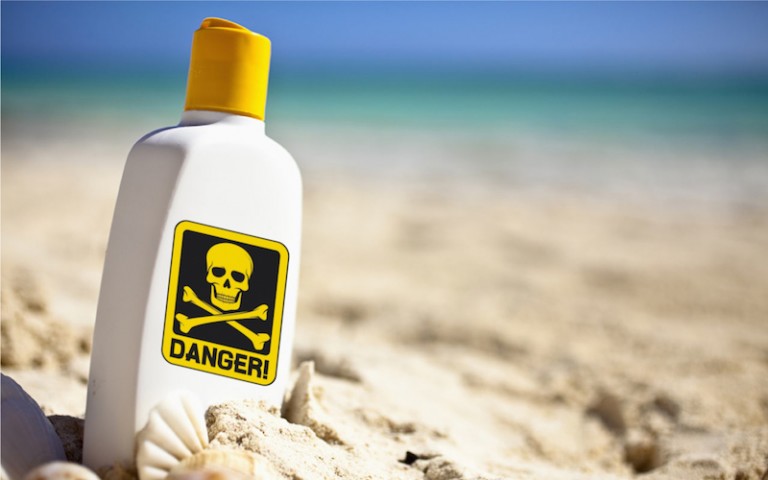
Rates of melanoma – the most deadly form of skin cancer – have tripled over the past three decades. Ironically, sunscreen sales have quadrupled during this time. In addition to lotions, sun protection is commonly added to shampoo, makeup, lipstick, nail polish and even clothing. With so much protection from the sun, why did we have less skin cancer thirty years ago, during a time when sunblock didn’t even exist? Most scientists and public health agencies – including the FDA itself – agree, there is very little evidence that sunscreen prevents most types of skin cancer. Even more surprising is the fact that the majority of products on the market designed to protect you from the sun can actually be hazardous to your health.
What you put on your skin gets absorbed into your bloodstream. Research published by The Environmental Working Group (EWG) revealed 84 percent of sunscreens contain chemicals that could lead to infertility, hormonal issues, thyroid dysfunction and a lowered immune system. Some common chemicals found in sunscreen have even been linked to causing cancer. Listeners of my radio show have often heard me say, “When reading food labels, if you can’t pronounce the ingredient, don’t put it in your mouth.” This can also be a rule of thumb when it comes to what you put on your skin.
Sunscreen Ingredients to Avoid:
Octylmethoxycinnamate, or sometimes listed as ethylhexylmethoxycinnamate (try saying that three times real fast!): This chemical is found in 80% of sunscreens and, according to the National Cosmetics Database, there are many concerns regarding its use, including: mutation of human cells upon exposure to sunlight (which is likely when used as a sunscreen ingredient;) lowered immune system, reproductive toxicity that leads to estrogenic effects, allergies, organ system toxicity, especially in the liver.
Retinylpalmitate: Federally funded studies show that this ingredient may trigger the development of skin tumors and lesions when used on skin in the presence of sunlight. Topical application of retinylpalmitate has also shown to cause toxicity to organ systems. In addition to sunscreens, this ingredient commonly shows up in lip balms, make up and skin moisturizers.
Oxybenzone: This chemical, which is found in 60% of sunscreens on the market, releases free radicals that actually contribute to the development of skin cancer. Oxybenzone also mimics estrogen which can lower men’s testosterone levels and lead to prostate cancer. In females, this chemical can cause endometriosis. This condition occurs when uterine tissue grows in abnormal sites in the abdomen and causes severe pain.
For a full list of sunscreen ingredients and brands you should avoid visit: www.ewg.org.
Healthy Sunscreen Choices
Now that we’ve got the chemicals to avoid out of the way, l’ll share some healthy and natural options to protect you from the damaging effects of the sun.
Coconut oil: Islanders have used coconut oil for hundreds of years. It moisturizes the skin and creates a nice dark tan. People from Hawaii and the Caribbean have less incidence of skin cancer.
Jojoba oil: This oil conditions and nourishes the skin and protects it from free radical damage.
Shea butter: This is a natural plant byproduct that has great moisturizing properties and protects the skin from getting burned.
Eucalyptus oil: This oil helps protect and revitalize the skin. It’s also a natural analgesic and helps with sore muscles and joint pain.
UVA and UVB Exposure
Sunlight contains several types of radiation, including UVA and UVB rays. It’s the UVA rays from the sun that are cancer causing. UVB rays are the good type because they help the body produce Vitamin D (which has cancer preventing properties!) Keep in mind though, UVB exposure for lengthy periods of time can lead to skin damage and give you that leathery look. The best time of the day to get the most UVB and the least cancer causing UVA exposure is between 2 PM and 4 PM. Dont over do it! Twenty minutes is all it takes to get enough vitamin D. When your skin is exposed to UVB rays, it can produce vitamin D at a rate of up to 1,000 international units per minute. Avoid sunscreen with “full spectrum” listed on the label because this means it will block out both UVA and the vitamin D producing UVB. Choose sunscreen that only offers “UVA protection.”
Most importantly, no matter what type of sunscreen protection you use, the key to healthy skin is to avoid getting sunburned. This is what damages your skin, accelerates aging, and leaves you more prone to developing skin cancer. While healthy sunscreen is a good option, nothing keeps you safer from burning than protective clothing, sunglasses. an umbrella and hat.
About the Author
Dr. David Friedman is the author of the award-winning, #1 national best-selling book Food Sanity, How to Eat in a World of Fads and Fiction. He's a Doctor of Naturopathy, Chiropractic Neurologist, Clinical Nutritionist, Board Certified Alternative Medical Practitioner, and Board Certified in Integrative Medicine. Dr. Friedman is a syndicated television health expert and host of To Your Good Health Radio, which has changed the face of talk radio by incorporating entertainment, shock value, and solutions to everyday health and wellness issues.
Read more hereFOODSANITY.COM .